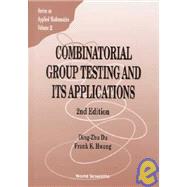There are two reasons for publishing a second edition of this book. The first is the usual need to update the text (after six years) and correct errors. The second -- and more important -- reason is to accommodate the recent sudden growth of interest in applying the idea of group testing to clone library screening. This development is much more than just a new application, since the new application brings with it new objectives which require a new twist of theory. It also embraces the growing importance of two topics: nonadaptive algorithms and








